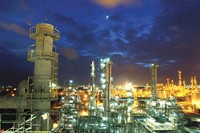Advertisement
Grab your lab coat. Let's get started
Welcome!
Welcome!
Create an account below to get 6 C&EN articles per month, receive newsletters and more - all free.
It seems this is your first time logging in online. Please enter the following information to continue.
As an ACS member you automatically get access to this site. All we need is few more details to create your reading experience.
Not you? Sign in with a different account.
Not you? Sign in with a different account.
ERROR 1
ERROR 1
ERROR 2
ERROR 2
ERROR 2
ERROR 2
ERROR 2
Password and Confirm password must match.
If you have an ACS member number, please enter it here so we can link this account to your membership. (optional)
ERROR 2
ACS values your privacy. By submitting your information, you are gaining access to C&EN and subscribing to our weekly newsletter. We use the information you provide to make your reading experience better, and we will never sell your data to third party members.
Business
Upbeat In Orlando
Software giant SAP racks up kudos at its Sapphire users conference
by Rick Mullin
May 29, 2006
| A version of this story appeared in
Volume 84, Issue 22

SAP's recent sapphire users conference introduced an element of redundancy to Orlando, Fla., a city that already has a popular "Back to the Future" attraction.
Business is booming again for the business software giant, which in the 1990s virtually conquered the market for enterprise resource planning (ERP) software in certain industries, including chemicals. At Sapphire, chemical company information technology (IT) managers were again talking about the importance of "CEO ownership" of big-ticket IT projects. And because many of them are embarking once more on major IT projects, just as they did 10 years ago, managers spoke of the need to realign business processes to operate on a single IT platform.
The focus is on SAP's latest generation of ERP software, mySAP ERP 2005. Based on the firm's Netweaver Internet-based platform, it supports software from multiple vendors.
SAP's act two garnered positive reviews from chemical industry IT managers and analysts at the show, some of whom have not always had raves for the company. "I've given SAP a pretty hard time over the last three years, highlighting significant gaps in their functionality for complex process industry requirements in general and the chemical industry in particular," writes AMR Research analyst Colin Masson in a report published just prior to Sapphire. Masson suspects that SAP, having fully penetrated chemicals by early this decade, turned its attention to smaller software users.
This year, however, there is good news for chemical industry SAP users, according to Masson: SAP's chemical industry business unit has listened more closely to customers and formed partnerships with application software providers, such as Vendavo, a pricing management software firm, in order to fill in the gaps. Masson told C&EN that IT spending in the chemical sector is up between 20 and 30% this year.
Abbe M. Mulders, chief information officer of Dow Corning, said energy costs are a key management focus in the sector, as is intellectual property. "We need to manage our intellectual property just as we manage our financial transactions," she said.
John L. Wheeler, Nova Chemicals' CIO, agrees with Masson that the software company's partnerships with specialist firms are paying off. He said Nova has tried integrating software from some of these specialists itself with little success and at a high cost. SAP's partnerships have made it easier, he said. "I think it's a change in SAP's idea of conquering the world," Wheeler said. "You can't be all things to all people."
Karl Wachs, CIO of Celanese, was more guarded in his enthusiasm. "SAP is moving in a good direction, but there is a long way to go," he said. "There are not that many partners yet, and if it takes longer than two years, such an initiative will die."
The big move in chemicals and elsewhere in recent years has been an upgrade of SAP's R3 ERP system to the Netweaver architecture. "We're in another round of infrastructure investment," said Michael H. Bittner, senior analyst with Technology Evaluation Center, a Montreal-based systems analyst. Investment, he said, has alternated between big infrastructure overhauls and spot purchases of business software applications.
But Joachim Hechler, senior vice president for ERP at SAP, sees simultaneous investment in infrastructure and applications, as well as a clear strategic thrust in the chemical sector. "In the 1990s, the chemical industry was heavily involved in getting everything implemented," he told C&EN. "Now they are working toward flexibility. They need systems that go beyond the legal requirements of financial reporting to handle things like the introduction of new processes and the integration of IT systems after mergers and acquisitions."
Mulders said Dow Corning is spending about $1 million to convert its Siebel customer relationship management system to competing SAP software as part of a broader ERP revamp. After the 1990s wave of IT investments, chemical companies need to consolidate systems, she said. And consolidation at Dow Corning is clearly centered on SAP. "They are closing the gaps and opening the system up," Mulders said.
Perhaps the biggest project news is SAP's recent contract to convert Dow Chemical's early-version mainframe-based SAP R2 system to mySAP. Dow, which has what SAP Chief Executive Officer Henning Kagermann told C&EN is the world's best implementation of R2, steadfastly resisted converting to R3, the client server-based system installed by most chemical companies in the 1990s.
Hasso Platner, one of the IBM consultants that founded SAP in the 1970s based on work done with ICI, said in a keynote speech that SAP, like its users, has had to bear down on system design in recent years. The theme, he said, is open-system architecture.
"We build a big system, then we consolidate it," Platner said. "This is what mySAP is all about. We've harmonized the applications, but it's happened over 10 years. And in that time, other companies have invented new stuff. The race is on again."





Join the conversation
Contact the reporter
Submit a Letter to the Editor for publication
Engage with us on Twitter